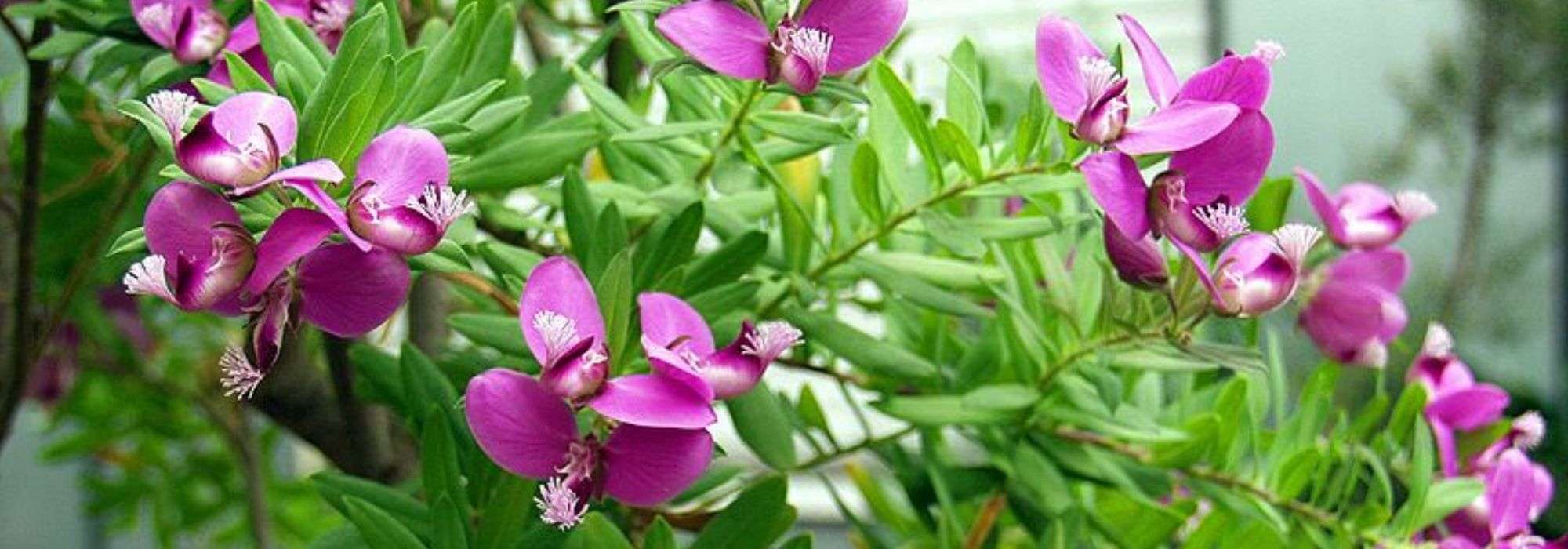
Polygala: planting, pruning, and caring for
Contents
Polygala, in a nutshell
- This small evergreen bush with Mediterranean accents offers a vibrant, abundant flowering from spring until frost.
- Its small grey-green to medium green leaves are adorned with scattered bouquets of violet-purple pea flowers often until December in mild climate zones.
- The compact, drought-resistant bush is suitable for pots as well as in a sunny rockery, on a bank, or as a small flowering hedge.
A word from our expert
Polygala planted for ornamentation are generally bushes of the species myrtifolia (myrtle-leaved) or hybrids resulting from the cross-breeding of this species with another bush. The overall appearance of their purple-pink flowers closely resembles that of the Fabaceae, evoking a flight of butterflies. The evergreen foliage made up of small grey-green leaves undoubtedly adds a Mediterranean touch, with the advantage of blooming throughout the summer, unlike many plants of this type that enter a summer dormancy phase.
You can create a lovely scene by simply placing the bush in a terracotta pot, positioned against a wall or on the steps of a stone staircase. The Polygala fits well in a modern garden with its compact habit and bright flowers that can be highlighted in a pot tinted plum, apple green, or anthracite.
It is a plant of mild climate, tolerant of wind, sea spray, soil salinity, and drought, thriving both on the Mediterranean coast and along the Atlantic shoreline. The only downside is its low hardiness – around -5°C for the Polygala myrtifolia – but Polygala hybrid ‘Bibi Pink’ overcomes this drawback as it can withstand frosts down to -12°C. Its denser and more compact habit also allows it to be easily stored in a bright, unheated room if your winters require it.
In mild climates, Polygalas also integrate beautifully into small hedges, borders, and rockeries, associated with other exotic bushes such as Melaleuca, Leptospermum, Medicago arborea, evergreen ceanothus, Abelia, or Escallonia. Plant them in well-drained soil, receiving maximum sunlight, in a city garden or by the seaside.
Description and Botany
Botanical data
- Latin name Polygala
- Family Polygalaceae
- Common name Polygala
- Flowering between March and October depending on the species
- Height between 15 cm and 2 m
- Exposure full sun
- Soil type any loose and well-drained soil, even calcareous
- Hardiness Low to moderate (-5 to -14 °C)
The genus Polygala encompasses numerous annuals, perennials, and a few bushes, comprising nearly 500 species that thrive in warm regions worldwide. It belongs to the Polygalaceae family, which is closely related to the Fabaceae family, with differences in flower and fruit shape.
Polygalas, particularly the herbaceous types, can be found in various environments ranging from dry meadows (Polygala comosa, calcarea) to wet meadows (Polygala austriaca, amarella) and the edges of forests in mountainous areas (Polygala chamaebuxus, vulgaris), identifiable by their small blue or bright pink flowers, sometimes bicoloured, with a white tuft. However, the myrtle-leaved Polygala (Polygala myrtifolia), which is the main cultivated bush species for ornamentation, requires a sunny environment and a mild climate, such as that of the Atlantic or Mediterranean coast. It is found in its natural state in South Africa, thriving on dunes, rocky slopes, stream banks, as well as in forests or areas of meadows or scrubland. Its hardiness does not exceed -5°C, but it can easily winter in a conservatory (between 0 and 15°C) and continue to flower for 10 months. There are, however, new compact hybrids like Polygala hybrid ‘Bibi Pink’ that can tolerate frosts down to -12°C, allowing for broader use across the territory. Polygala chamaebuxus, native but relatively unknown, is a perennial from the southern mountains, found from France (Alps and Pyrenees) to Romania, which withstands temperatures down to -14°C in well-drained soil. Its yellow and pink flowering is, however, more limited in duration compared to the South African species myrtifolia.
The flower of Polygala features 2 large coloured sepals resembling the wings of a butterfly, similar to the wings of the pea flower, and 3 other classic sepals, more discreet in size and greenish in colour. The corolla forms a tube made up of 3 to 5 fused petals, mimicking the keel of the Fabaceae flower (the lower petal). It typically ends with a tuft of white filaments arranged in a Y shape, which is very characteristic of polygalas, contrasting with the colour of the petals and corresponding to transformed stamens. The so-called “papilionaceous” flowers, like those of the Fabaceae, measuring 2 to 3 cm in Polygala myrtifolia, are grouped in short terminal clusters that are very ornamental. The flowering of this species can extend over 10 months of the year as long as it does not freeze.
The fruits are small winged flattened capsules, sometimes difficult to spot on the bush but which disperse numerous seeds. This polygala, like many others, self-seeds, sometimes abundantly, in the most unexpected places in the garden, given favourable climate and soil conditions.
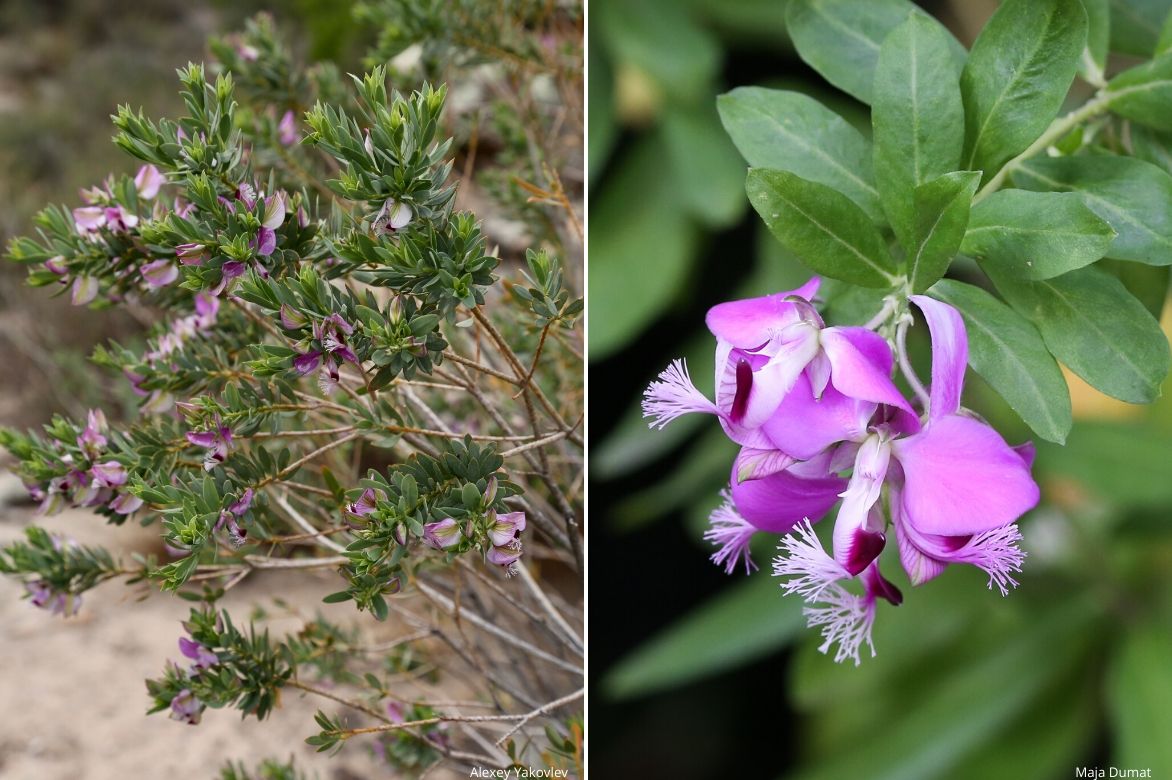 Polygala myrtifolia: a beautiful flowering bush for mild climates
Polygala myrtifolia: a beautiful flowering bush for mild climates
The simple foliage – not compound, unlike that of most Fabaceae, is arranged alternately and has virtually no petiole, as indicated by the names of the various species of Polygala (myrtifolia, serpyllifolia, chamaebuxus…) referring to the leaves of myrtle, thyme, and boxwood. In Polygala myrtifolia, the leaves are evergreen, ovate or pointed, pale green with varying shades of grey, measuring 2-3 cm long, with a more pronounced midrib. The compact bush, made up of fine and flexible intertwined green or purplish branches, can reach 1.5 to 2 m in all directions after 4 years under good conditions, while the Baby Pink hybrid does not exceed 0.8 to 1 m. One could say that its growth is rapid, which provides some consolation in case of loss due to cold or its short lifespan. In contrast, Polygala chamaebuxus, which has a creeping habit of 15 cm high and spreads over more than 50 cm in diameter, shows slow to very slow growth.
The etymology of the name Polygala comes from Greek and means “abundant milk,” referring to the properties of certain species of polygala that were believed to increase lactation in women, according to ancient Greeks.
The main varieties of Polygala
Most Widespread Species
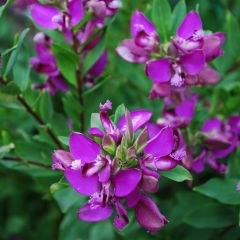
Polygala myrtifolia
- Flowering time June to November
- Height at maturity 2 m
Hardier and More Compact Species
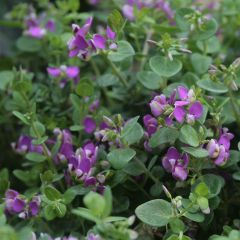
Polygala Bibi Pink
- Flowering time July to November
- Height at maturity 80 cm
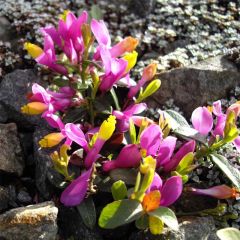
Polygala chamaebuxus Grandiflora
- Flowering time April to June
- Height at maturity 15 cm
Discover other Polygala
View all →Available in 1 sizes
Available in 2 sizes
Planting
Where to Plant Polygala?
Myrtle-leaved polygala can only survive in the ground in frost-free regions (maximum -5°C), except for the Baby Pink cultivar, which is slightly more tolerant (-12°C). In borderline areas, surround the bush with a winter cover to gain a few degrees of hardiness. You can easily grow the bush in a pot and place it in an unheated greenhouse, away from frost, or in a conservatory during winter where it can continue to flower. Choose a beautiful ceramic pot or a large container to showcase it well.
Place the polygala preferably in full sun except for Polygala chamaebuxus, which prefers partial shade in the Midi, to be treated like a rock garden plant on a shaded slope or on top of a wall, alongside anemones blanda or Cyclamen coum, for example.
Polygalas are not fussy about soil: acidic, neutral, calcareous, moist, dry, as long as it is well-drained.
When to Plant?
Preferably choose spring after the last frosts to plant the polygala, except in the Mediterranean where autumn planting is recommended.
How to Plant?
This fast-growing plant is easy to cultivate, especially in pots.
- Soak the pot in a bucket of water to thoroughly moisten it.
- Dig a wide hole deep enough, 2 to 3 times wider than the root ball.
- Add a handful of sand or gravel to the bottom of the hole or pot to ensure good drainage around the roots. In heavy soil, opt for planting within a rock garden.
- In pots as well as in the ground, fill the hole with a mixture composed of 1/3 garden soil, 1/3 potting soil, and 1/3 river sand (coarse sand) or gravel.
- Lightly compact it to form a basin.
- Water generously.
Learn more at: Growing Polygala in a Pot.
Maintenance and pruning
- Remember to water the pot-grown Polygala regularly during hot periods. Once well established, it tolerates drought fairly well when growing in open ground.
- Top up the pot with fresh compost in spring to maintain good fertility. In open ground, a bit of compost at the base will suffice from time to time.
- Prune any overhanging branches if necessary at the end of spring before it begins a second wave of flowering. However, in general, the shrubby Polygala should not be pruned as it struggles to regrow on old wood, similar to cistus or rosemary. Pruning in autumn may encourage it to produce new shoots that are sensitive to cold.
- Remove any dead wood at the beginning of spring.
- The Polygala is rarely subject to diseases or pests outdoors. Indoors, you may observe whiteflies (aleurodids) and aphids on young shoots. Apply nettle manure, black soap, pyrethrin, or prune the affected shoots to eliminate them.
Multiplication
The simplest multiplication method involves sowing fresh seeds in spring or early summer, as propagation by cuttings is difficult.
Sowing
- Harvest the flat fruits containing seeds from the Polygala at the end of summer and store them in a dry place.
- Sow the fresh seeds in a cold frame or in a sheltered area against a wall that is not too sunny, on loosened and moistened soil, covering them lightly.
- Germination takes a few weeks.
- Transplant the seedlings into pots when you can handle them, taking care not to break the radicle.
- Keep the plants sheltered during the first two winters before planting them out.
Uses and Associations
Polygala myrtifolia and Pink Baby can adorn small sunny beds or rockeries alongside cistus, creeping ceanothus, lavenders, or rosemaries, Medicago arborea, or in a more southern spirit with Melaleuca, Leptospermum, Westringia… Ceanothus, Escallonia, Euphorbia mellifera or x martinii, Euryops, Leucadendron, and Watsonia are good companions for Polygala myrtifolia in Brittany on a slope facing the ocean.
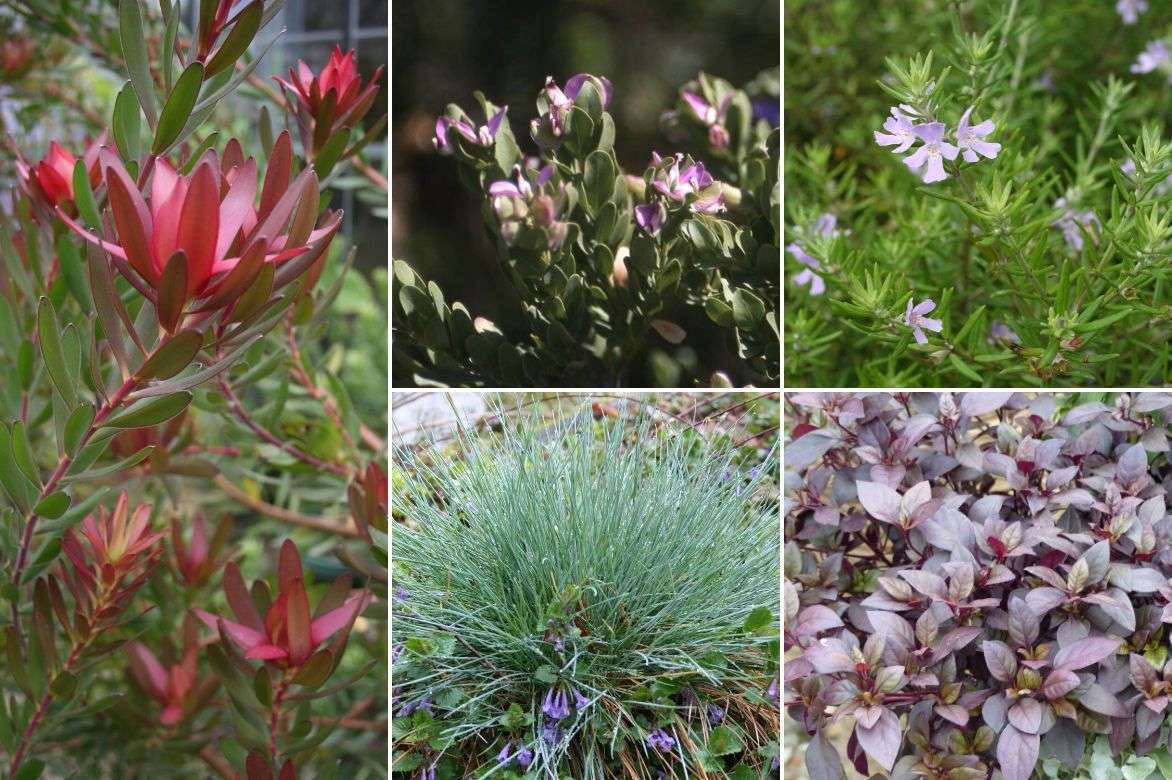
An idea for pairing in a mild climate: Leucadendron (‘Fireglow’ or ‘Safari Sunset’ for example), Polygala myrtifolia, Westringia fruticosa, Festuca glauca and Alternanthera ‘Little Prince’ or ‘Purple Night’. A Mexican blue palm (Brahea armata) would also be perfect
You can also create free-flowing borders that bloom almost all year round or fill rockeries. Polygala chamaebuxus ‘Grandiflora’, resembling a creeping cotoneaster, is particularly suited for this type of use. This undershrub is ideal for hugging the shape of rocks and enlivening the rockery with its bright spring flowering alongside alyssum or aubrieta. It is also an excellent plant for dressing shaded borders, slightly ungrateful slopes that receive little sunlight, the top of an inhospitable wall for sun-loving plants. It can be paired, for example, with hepatica (Hepatica nobilis), anemone blanda, or Cyclamen coum, which flower at the same time and enjoy the same conditions.
Feel free to fill large ceramic pots to brighten your balconies, terraces, or entrances, even for just one season, with Polygala myrtifolia. It is particularly suited for seaside gardens, as it shows great tolerance to strong winds and soil and air salinity.
Alexandra offers more pairing ideas with Polygala in this article!
For further reading
- Discover our range of Polygala.
- Protecting Polygala from the cold: our wintering tips
Frequently asked questions
-
My myrtle-leaved polygala is yellowing and losing its leaves. Why?
It is normal for the older leaves at the base of the bush to eventually yellow and fall off, but general yellowing often indicates excess water at the roots. Do not let water stagnate in a saucer after watering, as this bush prefers well-aerated, draining soils. Repot if necessary in a new well-draining substrate made of potting soil, sand, and garden soil.
- Subscribe!
- Contents
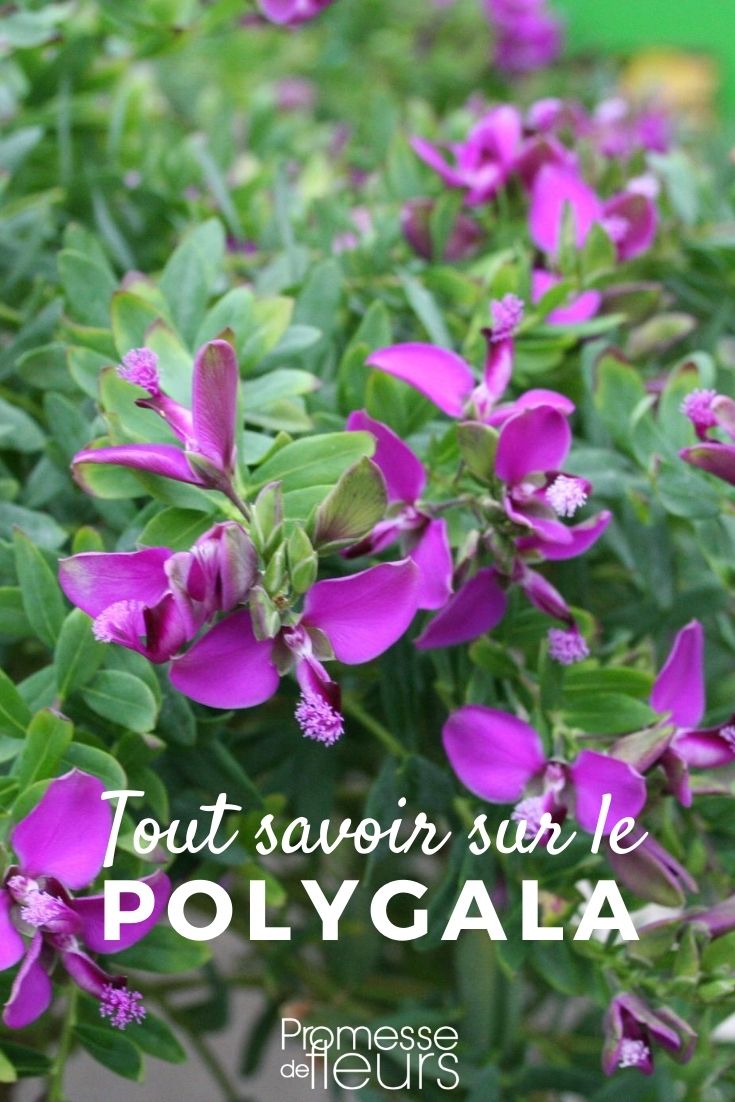

































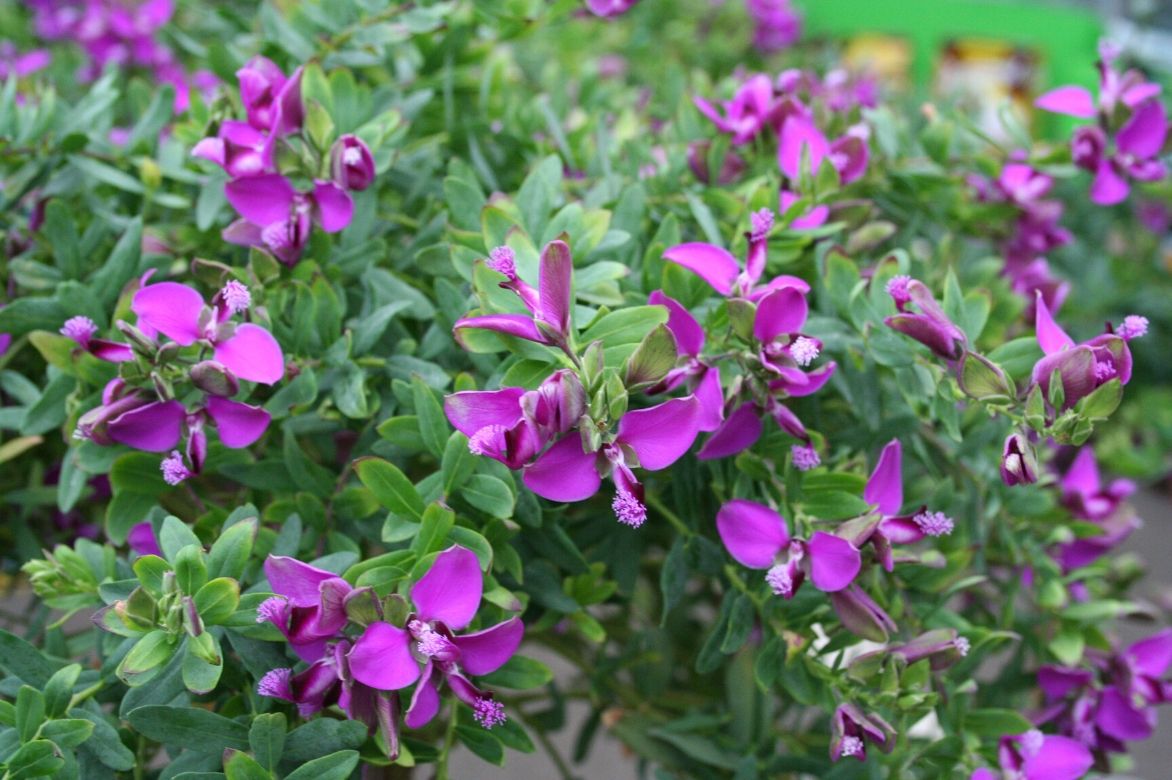
Comments